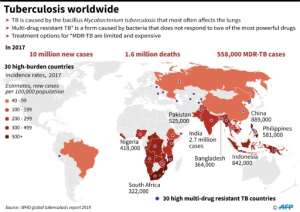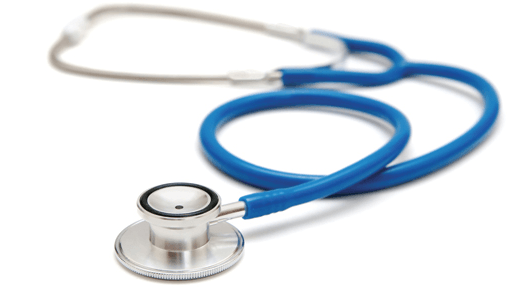
From a revolutionary way of testing children for tuberculosis to a cure for a previously untreatable strain, scientists from across the globe launched a fresh broadside Thursday against the world's deadliest infectious disease.
Tuberculosis, a severe lung infection that is curable but historically hard to detect, kills more people each year than HIV/AIDS, and more than three times more than malaria.
Despite its potency -- there were 1.7 million TB deaths in 2017 and certain strains are more deadly than Ebola -- efforts to confront the disease have lagged behind those aimed at other communicable diseases.
More than 4,000 experts on lung health are gathering this week in The Hague and on Thursday they unveiled several new weapons in the battle against tuberculosis.
One potential game changer is a new method of testing children under five for the disease.
An estimated 240,000 children die from tuberculosis every year. The disease is curable and rarely deadly in infants if diagnosed and treated in time.
But as much as 90 percent of tuberculosis deaths in children are untreated cases.
 Graphic on the global incidence of TB, including 558,000 multi-drug resistant cases in 2017. By John SAEKI (AFP)
Graphic on the global incidence of TB, including 558,000 multi-drug resistant cases in 2017. By John SAEKI (AFP) The current test relies on the patient providing a sample of sputum -- phlegm from the lower windpipe.
The sample is then analysed by a special machine, which then gives a result.
But as children under five cannot spit up sputum, doctors have to submit them to an invasive and painful procedure that often requires staying the night in hospital.
Researchers in Indonesia and Ethiopia found a way of testing children's stool for the disease instead, meaning there would be no need for them to travel to a large health facility and they could be examined even in small villages or remote rural areas.
Petra de Haas, laboratory consultant at the KNCV Tuberculosis Foundation which developed the method, told AFP the test could save many of the 650 children who die of tuberculosis every day.
"This is a real breakthrough because this can be done in small laboratories," she said.
"We know already that a quarter of a million children die (every year). If they all got this test we could save at least half of them."
New drug hope
"No child should die from TB," said Jose Luis Castro, head of the International Union Against Tuberculosis and Lung Diseases.
"Promising breakthroughs of this kind are needed if we are to make inroads into preventing illness and death from tuberculosis."
Scientists also unveiled the results of countrywide use of a new drug used to treat strains of tuberculosis that are resistant to most antibiotics, and therefore extremely difficult to kill.
Experts believe the strains are spreading worldwide due to poor handling of tuberculosis cases and has been noted by the World Health Organization in more than 100 countries.
A new drug, bedaquiline, has shown impressive results in countries such as Belarus, South Africa and Vietnam -- all of which have high rates of multidrug-resistant TB.
Researchers Thursday that in Tajikistan, a former Soviet state where multidrug-resistant tuberculosis is widespread, 72 percent of patients given bedaquiline were either cured or completed their treatment.
In neighbouring Kyrgyzstan, the success rate was 74 percent.
Last month UN member states agreed to a global plan to fight tuberculosis and allow cheaper access to vital drugs, such as bedaquiline.
They put the cost of meeting the goal of ending tuberculosis by 2030 at $13 billion annually.
Angelina Grab, a nine-year-old tuberculosis survivor from South Africa, told AFP she was grateful for the advances already made in the battle against the killer disease.
"I remember I didn't like having to take this bitter, disgusting medicine for half a year," she said.
"But I knew if I didn't take it I wouldn't get better. I'm grateful for being this lucky and healthy now."
Read Full Story



















Facebook
Twitter
Pinterest
Instagram
Google+
YouTube
LinkedIn
RSS